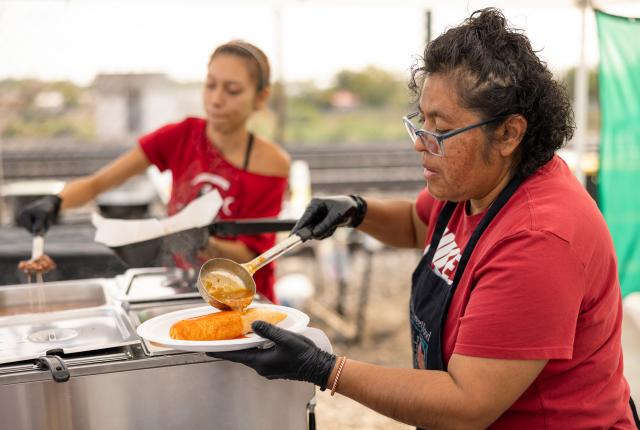IF YOU DON’T GET to Pueblo Street Food’s booth at Albuquerque’s Downtown Growers’ Market in time, you might miss out on some of the biggest and best-tasting red chile pork tamales in New Mexico—flavor-packed gifts from generations of chile growers and expert home cooks.
Tara Benavidez, a member of Santo Domingo (Kewa) Pueblo and the owner of Pueblo Street Food, explains that her secret lies in the smoky flavor of the red chile—and the chile itself.
Two family farms, one in Santo Domingo and another in San Felipe, grow the Indigenous crop. “From my grandma to my mom, we always dry the green chile out,” Benavidez says. “They turn red, and we start taking the stems and seeds out. Then we roast them.”
In her family, bread baking in a traditional horno is a regular event, and the chiles are roasted in the residual baking heat. The sometimes-intense spiciness of Benavidez’s tamales is best tamed with a piece of sourdough Pueblo bread, another highlight of Pueblo Street Food’s menu.
Benavidez emphasizes that it’s important to keep all the tamale ingredients cold before cooking to prevent the filling from becoming too loose. She grinds posole into masa, portions it out, and flattens it in a press, using nonstick sheets to ensure it stays intact during a short stay in the fridge. Chilled red-chile-braised pork is then portioned into the cold masa rounds, which are rolled burrito-style while still inside the nonstick sheets.
The assembled tamales are chilled again before wrapping in two large corn husks and tied tightly to create the signature indentations at the ends. They’re then frozen or refrigerated until cooking. Benavidez prefers boiling them.
“Every Friday night, we take them out of the freezer. Early at 3 a.m., we boil them,” she says of the preparation for the Downtown Growers’ Market that takes a week in total. “It’s a big process,” she says.
Pueblo Street Food tamales are also available at the Rail Yards Market on Sundays and on Pueblo feast days.
FARM TO FAMILY TABLE
To say that Christmastime for Polvadera farmer Cecilia Rosacker is all about family isn’t entirely true—it’s also all about the food. “The kitchen is at the center of the family,” says the multigenerational New Mexican and director of the Rio Grande Agricultural Land Trust. “We eat what we and other local farms grow because we’re from this land and share a love of this place and culture,” Rosacker says. Her winter squash and green chile Christmas tamales are a team effort, she says, with son Carlos and daughter-in-law Zoey now making Grandma Rita’s masa. “Try to use local lard,” Zoey says, for its rich flavor. “Polk’s Folly Farm, in Cedar Crest, is a great source.” Last Christmas, her farm-to-table filling for tamales included homemade goat-milk mozzarella, but Zoey says any local cheese, like feta or a mild cheddar, works great. —Candolin Cook
- 5 pounds winter squash (e.g. jester, butternut, red kuri)
- 2 tablespoons extra-virgin olive oil
- Salt and pepper, to taste
- 2 cups desired cheese, shredded or crumbled
- 1 cup green chile, roasted, peeled, seeded, and chopped
- 2 cups lard
- 6½ cups Maseca Tamal corn masa flour
- 2½ teaspoons salt
- 1 tablespoon (plus 2 teaspoons) baking powder
- 4½ cups warm water
- 2 dozen corn husks, plus a few more for steaming
Makes about 2 dozen
-
Preheat oven to 350°. Halve squash, remove seeds, and drizzle with olive oil, salt, and pepper. Roast cut-side down on a foil-lined sheet pan for about 45 minutes. Let cool, then scrape the roasted flesh into a bowl and mash until smooth.
-
Mix cheese and green chile into squash mash. Season with salt and pepper.
-
For dough: In a saucepan, melt lard. Set aside. In a big bowl, add tamale flour, salt, and baking powder, mix. Add warm lard slowly to the bowl with dry ingredients, mixing constantly. Add warm water slowly, mixing constantly, until dough is completely integrated, soft, and smooth.
-
Soak husks in hot water for a few minutes, then drain (this makes them easier to fold).
-
Spread a spoonful of masa thinly across the top two-thirds of each husk, keeping the bottom skinny side bare for folding.
-
Add about 2 tablespoons of the filling in a centered strip. Fold the bottom up and fold the sides together and tie with a thin strip of corn husk.
-
Place a steamer basket in a large pot with 1 inch of water. Layer tamales in a pyramid, cover with extra husks and lid, and steam, refilling water as needed. After 45 minutes, test doneness. The husk should pull away cleanly and the masa firm but spongy.



